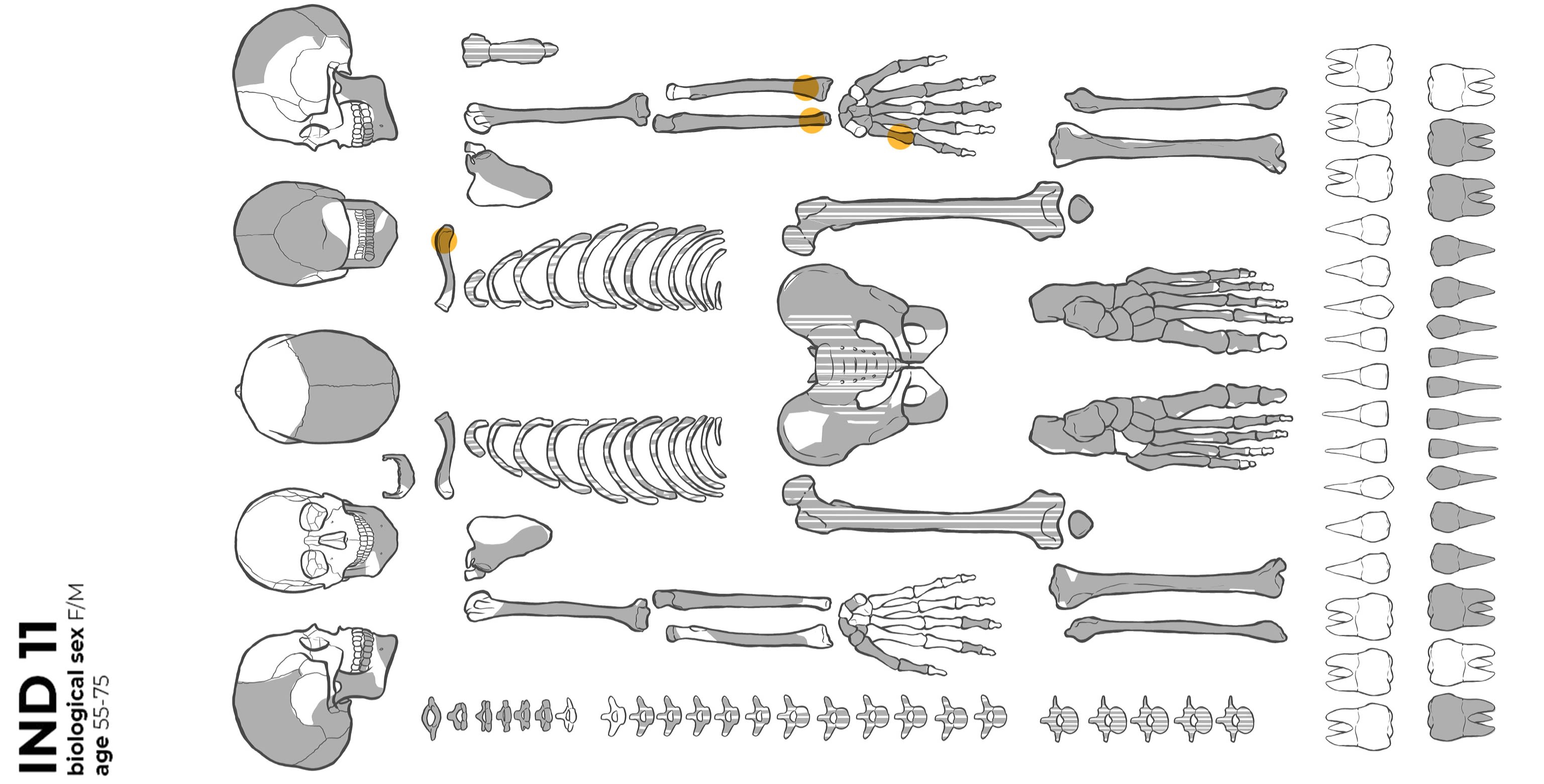Bioarchaeology aids the cultural understanding of 'Six Characters in Search of their Agency'

The Etruscan city of Tarquinia has been the subject of excavations and research by the University of Milan since 1982, initiated by Maria Bonghi Jovino, emeritus professor, and now under the direction of Giovanna Bagnasco, full professor. Professor Bagnasco is an honorary research associate of the McDonald and was a visiting Dunbarney fellow of Magdalene College in Michaelmas 2022 when this article was drafted.
The 'monumental complex,' one of the deepest stratigraphies investigated in the city, revealed the ancestral sacred site around which the ancient community first aggregated and then solidified, with occupation spanning from the 10th century BC to the Roman imperial era.
Twenty unexpected inhumations were discovered at this site, deposited in a sacred area within the city, in stark contrast to the typical contemporary cremations located in necropolises on the city's outskirts.
Micromorphological study by Gianbattista Marras of sediments from the site | Credit: Science@Tarquinia
Micromorphological study by Gianbattista Marras of sediments from the site | Credit: Science@Tarquinia
Sorting of sieved residue from the site by Frijda Schmidt | Credit: Science@Tarquinia.
Sorting of sieved residue from the site by Frijda Schmidt | Credit: Science@Tarquinia.
The excavation | Image credit: Tarquinia Project
The excavation | Image credit: Tarquinia Project
A recent collaborative article from the University of Milan, Cambridge Science@Tarquinia, and other international researchers and laboratories sought to find the answers to the following questions:
1. Why, when cremation was usual funerary practice, were these individuals buried in a sacred area?
2. As these individuals shared commonalities in the way that they were buried, did they also share other similarities?
3. Did these individuals come from Tarquinia? Or were they from further afield?
In order to find answers to these questions, the team used a series of interlocked interdisciplinary, archaeological, and biological research techniques.
These techniques included a combination of osteoarchaeology, isotope analysis, radiocarbon dating, ancient DNA and geoarchaeology; a combination unique in Etruscan studies.
The results of the paper confirmed that these individuals were indeed treated in a special way. Based on current evidence, some of them appear to have been visibly different from the rest of the community in terms of their origins and life course. The team have identified at least one key individual of peri-Baltic ancestry with supportive isotopic values for mobility.
In the spirit of Pirandello, the paper's namesake, the 'six authors' found in the stratigraphy have offered, through osteological analysis and other scientific analyses, a narrative of themselves and their living conditions.
The team conclude that the evidence suggests that distinctive individuals were selected by the community for rituals based around the ancestral core of the 'monumental complex', whose importance has already been grasped by archaeological research conducted over the last forty years.
In future research, the team hope to ascertain the relatedness of the six individuals studied in this paper with the remaining fourteen individuals buried at the site. They also hope to elucidate to what extent they differ from the vast majority of the community that was cremated rather than interred.
Skeleton 19 studied in the article | Credit: Tarquinia Project
Skeleton 19 studied in the article | Credit: Tarquinia Project
Measuring animal bones | Image credit: Tarquinia Project
Measuring animal bones | Image credit: Tarquinia Project
Overview of the state of preservation and location of the injuries of the six skeletons under study | Image credit: Cristina Cattaneo and Lucie Biehler-Gomez (University of Milan)
Overview of the state of preservation and location of the injuries of the six skeletons under study | Image credit: Cristina Cattaneo and Lucie Biehler-Gomez (University of Milan)
Members of the team using a flotation machine | Credit: Science@Tarquinia
Members of the team using a flotation machine | Credit: Science@Tarquinia
Tomb of the Jugglers, Tarquinia | Credit: Tarquinia Turismo.
Tomb of the Jugglers, Tarquinia | Credit: Tarquinia Turismo.
The paper is published in Scientific Reports here.
Central finance was provided by an AHSS International Research Strategy Working Group Grant (IRSWG) of the University of Cambridge with matching funds from Milan (2019-2023), supported further by a Wellcome grant awarded to Trinity College, Dublin. The McDonald Institute for Archaeological Research and Magdalene College, Cambridge have provided further support.
The Marie Skłodowska-Curie Actions–European Commission provided a research grant for Carmen Esposito (a former MPhil student from the department) (Grant HORIZON-MSCA-2021-PF-01-101065320).
Simon Stoddart would like to thank the Deutsche Forschungsgemeinschaft (DFG, German Research Foundation) – Project-ID 290391021 – SFB 1266 based in the University of Kiel for the stimulating environment under which this article was written. The Dfg also supported isotopic analysis at the University of Frankfurt.
The team is centred on a collaboration between the Universities of Milan and Cambridge. The team comprises archaeologists of two traditions (Bagnasco and Stoddart), isotope specialists, aDNA specialists, geoarchaeologists, plant and animal analysts. The team will continue their work later this year in Tarquinia, with an Open Day planned for 21-22 September called Civita Aperta.
Cambridge Doctoral students, Frijda Schmidt and Gianbattista Marras, contributed the information on plant remains and geoarchaeology respectively within the article.
The team: Bagnasco, G.*, Marzullo, M., Cattaneo, C., Biehler-Gomez, L., Mazzarelli, D., Ricciardi, V., Müller, W. , Coppa, A., McLaughlin, R., Motta, L., Prato, O., Schmidt, F., Gaveriaux, F., Marras, G.B., Millet, M.A., Madgwick, R., Ballantyne, R., Makarewicz, C., Trentacoste, A., Reimer, P., Mattiangeli, V., Bradley, D.G., Malone, C., Esposito, C., Breslin, E.M., and Stoddart, S.*
To find out more about the project see the project webpage.

Published 28 May 2024
The text in this work is licensed under a Creative Commons Attribution 4.0 International License










